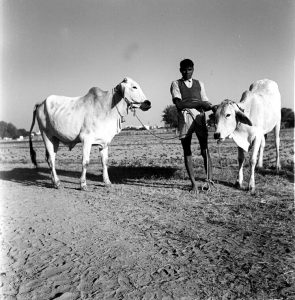Grid-connected solar irrigation offers farmers an additional income source, and if priced attractively, can reduce water draws
The season of election promises is over, arguments have been won and lost on the hustings, but the problems are waiting to be solved.
Agrarian distress is real and persisting, water is growing into an ever bigger human crisis, the state power sector has once again managed to bring itself to the edge of the precipice, and the human and fiscal cost of the downward-spiraling nexus between energy, water, and agriculture is staggering.
How do you double farm income without making the farmer dole and debt-waiver dependent? Impressive advancements and rapidly falling prices of solar technology and the recently announced KUSUM scheme of the Centre offer a promising solution.
The KUSUM scheme has three components: (a) private sector-led large-scale solar at sub-stations; (b) off-grid solar irrigation and (c) grid-connected solar irrigation. Components (a) and (b) either do not solve the real problems of perverse nexus or only improve power supply but cause further damage to groundwater.
Our analysis shows that Component (c) can potentially double the farm income, save groundwater, save subsidies for the State government, and generate jobs.
Political economy in a bind: More than 80 percent of freshwater is used by agriculture, and more than 60 percent of India’s irrigated agriculture is via groundwater. “Unmetered” and subsidized energy for agriculture has created recurring fiscal pressure and burdened industry with cross-subsidy.
Repeated bailouts of the State power sector reflect the way the state power sector has been managed and governed. Sixty-five percent of India’s rural population depends on 15 percent of its GDP contributed by agriculture, growing at an annual average of less than 2 percent. The average income of agricultural households in India is less than ₹9,000 per month of which only about half is contributed by farm income (Nabard All India Financial Inclusion Survey 2017).
India cannot address its water and energy economy without addressing agrarian distress and finding non-agriculture income options. Connecting the solar irrigation pumps to the grid to sell surplus electricity provides an additional source of income for the farmer which has been amply demonstrated by the International Water Management Institute (IWMI) through a pilot project in Dhundi (Solar Power as a Remunerative Crop- SPaRC) and NDDB’s solar cooperative in Majkuva (Gujarat).
In a recent pilot launched by Punjab (Pani Bachao, Paisa Kamao with which authors are closely associated) farmers have demonstrated a saving of about 30 percent due to daytime power supply and the ability to optimize the use of water.
Triple win
A recent analysis carried out by the authors on a few 11kV electricity feeders of Rajasthan shows that with grid-connected solarisation of pumps: (i) farmers would get a substantial increase in their income that is climate resilient and counter-cyclical to agriculture, and get daytime, reliable, free power supply which reduces their production risk; (ii) recurring power subsidy to agriculture would get replaced by one-time capital subsidy; and (iii) Discoms would get cheap decentralized distributed generation that would reduce their network losses.
Assuming replacement of one horsepower load by 1.5 kW, sale of surplus power at Discom’s average power purchase cost, conversion of 70 percent farmers on a feeder to solar, and the financing structure of KUSUM-C i.e. 30 percent subsidy by Central and State government each, 10% equity by the farmer and a loan of 30 percent for seven years at an interest rate of 10 percent, Table 1 shows the profits for the farmer, government, and the Discom. If we add the value of free solar power for irrigation, the farmer’s benefit would be even higher. The farm income of a typical farmer would increase by about 30 percent during the 7 years of loan repayment and by more than 100 percent thereafter. During drought and crop failure, farmers can reduce the scale of agriculture and earn more money from the sale of power. Government subsidy is not an expenditure but a very profitable investment that would save the Government a recurring subsidy of ₹56,000 per farmer- a return of about 30 percent.
Drought premium: During droughts, the farmer can reduce the scale of agriculture and earn more money from the sale of power. The government would be well advised to pay a “drought premium” for the sale of power thus encouraging the farmer to optimize the use of scarce water and adopt a de-minimis approach of using water only for drinking and growing enough food and fodder for his family and his cattle. Drought premium also offers an instrument for direct delivery of drought relief into the bank accounts of farmers.
Why do we need an FPO/cooperative for this scheme? For grid-connected solar to work, the Discom must keep the feeder “on” during the day as against the current system of supply of four to six hours to contain subsidy. Yet, if a significant number of individual farmers are unable or unwilling to solarise, their power and water consumption would go up since power will be now available for almost 10 hours a day every day, and even the subsidy burden on the government would increase. Illegal use and bypassing of meters could increase.
Therefore, the scheme should be made available only if at least 70 farmers participate (as done by Gujarat) and establish a Farmer Producer Company (FPC) or cooperative. The FPC would sign the PPA, aggregate power from participating farmers, maintain the feeder, and carry out energy accounting based on net meters at the farm and at the sub-station. Formation of FPC would check theft since stolen power belongs to the neighbor and not the government.
Undoubtedly, the formation of FPCs, mobilizing farmers to participate, and finding debt and equity financing for farmers would be effort intensive but is the most sustainable model of doubling farm income with dignity, saving water, and eliminating anarchy in the agricultural power supply.
Costs of national scale-up
India has about 21 million electric pumps. Focusing initially only on some large States to solarise 20 percent of farm connections, capital subsidy from Central and State governments would be ₹35,000 crore each, farm loans of ₹35,000 crore, and farmer equity of ₹11,000 crore which could be financed by banks against collateral of solar assets.
Increasing the farm income of 4 to 5 million farmers by 30 percent and putting them well on their way to doubling their farm income would be no mean achievement in five years. In addition, even excluding upstream manufacturing jobs in solar cells, this could generate about 50 million local job days over five years.
Risks and challenges
The risk of delays and defaults in payment for the purchase of power by financially distressed Discoms can undermine this huge opportunity. The government can help catalyze the market by getting the national renewable trader (NVVNL) to buy power from FPCs and sell it to NTPC which can pool it into its large (270 billion kWh) market. Any cost differential could be underwritten by the Centre for the first few years to create a market.
Due to pre-existing large stranded capacity, some Discoms may not be inclined to encourage additional generation. However, the stranded surplus could vanish in the next five to seven years before India reaches a disruptive scale of solarisation.
Mission to farmer dignity: The government should create a “KUSUM Mission” with an adequately funded anchor organization at the Centre and a similar organization in each participating State. These organizations should draw staff from agriculture, water, energy, and financial sectors from the public, private, and civil society entities and should be led by a hand-picked leader with a clear target of achieving 20 percent solar conversion within five years.
NDDB’s expertise in engaging farmers and creating cooperatives would be handy in training these anchor organizations. The dynamism of the private sector should be tapped to create FPCs. The agriculture distress, water crisis, and fiscal distress caused by the power sector have set a fertile ground to take advantage of affordable solar and achieve two grand objectives doubling farm income and improving India’s water security.
Gulati is the former Chief Operating Officer, of United Nations Sustainable Energy for All, and Sampath is the former Chief Election Commissioner of India
source: thehindubusinessline
Link:https://www.thehindubusinessline.com/opinion/solar-irrigation-can-transform-rural-india/article28322085.ece


